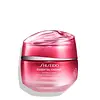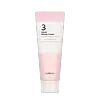What's inside
What's inside
 Key Ingredients
Key Ingredients

 Benefits
Benefits

 Concerns
Concerns

 Ingredients Side-by-side
Ingredients Side-by-side

Water
Skin ConditioningDimethicone
EmollientButylene Glycol
HumectantAlcohol Denat.
AntimicrobialBetaine
HumectantGlycerin
HumectantIsohexadecane
EmollientHydrogenated Polydecene
EmollientPPG-3 Dipivalate
Skin ConditioningSilica
AbrasiveBehenyl Alcohol
EmollientStearyl Alcohol
EmollientMyristyl Myristate
EmollientGlyceryl Stearate Se
EmulsifyingPolysorbate 60
EmulsifyingPEG-100 Stearate
PEG/PPG-14/7 Dimethyl Ether
Skin ConditioningPEG/PPG-17/4 Dimethyl Ether
Skin ConditioningPhenoxyethanol
PreservativeDimethylacrylamide/Sodium Acryloyldimethyltaurate Crosspolymer
CI 77891
Cosmetic ColorantSorbitan Tristearate
EmulsifyingErythritol
HumectantParfum
MaskingAlcohol
AntimicrobialAminopropyl Dimethicone
2-O-Ethyl Ascorbic Acid
Skin ConditioningCarbomer
Emulsion StabilisingTrisodium EDTA
Xanthan Gum
EmulsifyingCaffeine
Skin ConditioningPotassium Hydroxide
BufferingIsostearic Acid
CleansingSodium Metaphosphate
BufferingPhytosteryl/Octyldodecyl Lauroyl Glutamate
Skin ConditioningAluminum Hydroxide
EmollientLinalool
PerfumingTocopherol
AntioxidantSodium Metabisulfite
AntioxidantLimonene
PerfumingCitrus Unshiu Peel Extract
MaskingSodium Hyaluronate
HumectantAngelica Keiskei Leaf/Stem Extract
Skin ConditioningZiziphus Jujuba Fruit Extract
Skin ConditioningPanax Ginseng Root Extract
EmollientSodium Acetylated Hyaluronate
HumectantScutellaria Baicalensis Root Extract
AstringentCI 77491
Cosmetic ColorantAlpinia Speciosa Leaf Extract
Skin ConditioningRosmarinus Officinalis Leaf Extract
AntimicrobialSanguisorba Officinalis Root Extract
CleansingPyrola Incarnata Extract
Skin ConditioningWater, Dimethicone, Butylene Glycol, Alcohol Denat., Betaine, Glycerin, Isohexadecane, Hydrogenated Polydecene, PPG-3 Dipivalate, Silica, Behenyl Alcohol, Stearyl Alcohol, Myristyl Myristate, Glyceryl Stearate Se, Polysorbate 60, PEG-100 Stearate, PEG/PPG-14/7 Dimethyl Ether, PEG/PPG-17/4 Dimethyl Ether, Phenoxyethanol, Dimethylacrylamide/Sodium Acryloyldimethyltaurate Crosspolymer, CI 77891, Sorbitan Tristearate, Erythritol, Parfum, Alcohol, Aminopropyl Dimethicone, 2-O-Ethyl Ascorbic Acid, Carbomer, Trisodium EDTA, Xanthan Gum, Caffeine, Potassium Hydroxide, Isostearic Acid, Sodium Metaphosphate, Phytosteryl/Octyldodecyl Lauroyl Glutamate, Aluminum Hydroxide, Linalool, Tocopherol, Sodium Metabisulfite, Limonene, Citrus Unshiu Peel Extract, Sodium Hyaluronate, Angelica Keiskei Leaf/Stem Extract, Ziziphus Jujuba Fruit Extract, Panax Ginseng Root Extract, Sodium Acetylated Hyaluronate, Scutellaria Baicalensis Root Extract, CI 77491, Alpinia Speciosa Leaf Extract, Rosmarinus Officinalis Leaf Extract, Sanguisorba Officinalis Root Extract, Pyrola Incarnata Extract
Water
Skin ConditioningPropanediol
SolventGlycerin
HumectantNeopentyl Glycol Diheptanoate
EmollientCyclohexasiloxane
EmollientPolyglyceryl-3 Methylglucose Distearate
EmulsifyingMethylpropanediol
SolventCetyl Alcohol
EmollientGlycereth-26
HumectantGlyceryl Stearate
EmollientNiacinamide
SmoothingDicaprylyl Ether
EmollientCetyl Dimethicone
EmollientButyrospermum Parkii Butter
Skin ConditioningHydrogenated Polyisobutene
EmollientPentaerythrityl Distearate
EmulsifyingTrehalose
HumectantPentylene Glycol
Skin ConditioningDioscorea Japonica Root Extract
Skin ConditioningPiper Methysticum Leaf/Root/Stem Extract
Skin ConditioningCentella Asiatica Extract
CleansingPanax Ginseng Berry Extract
Skin ConditioningSaponaria Officinalis Extract
Skin ConditioningHydrogenated Lecithin
EmulsifyingSodium Hyaluronate
HumectantPolyglyceryl-10 Laurate
Skin ConditioningGlyceryl Caprylate
EmollientSodium Polyacrylate Starch
AbsorbentAcrylates/C10-30 Alkyl Acrylate Crosspolymer
Emulsion StabilisingGlycosyl Trehalose
Emulsion StabilisingTromethamine
BufferingSodium Stearoyl Glutamate
CleansingHydrogenated Starch Hydrolysate
HumectantAdenosine
Skin ConditioningRaffinose
Skin ConditioningDisodium EDTA
Lecithin
EmollientPolyquaternium-51
Skin ConditioningButylene Glycol
HumectantPanthenol
Skin ConditioningBeta-Glucan
Skin ConditioningSynthetic Fluorphlogopite
Folic Acid
Skin ConditioningCeramide NP
Skin ConditioningCholesterol
EmollientTetradecyl Aminobutyroylvalylaminobutyric Urea Trifluoroacetate
Skin ConditioningBiosaccharide Gum-1
HumectantIsomalt
HumectantMagnesium Chloride
Palmitoyl Pentapeptide-4
Skin ConditioningParfum
MaskingEthylhexylglycerin
Skin Conditioning1,2-Hexanediol
Skin ConditioningCI 77491
Cosmetic ColorantCitronellol
PerfumingGeraniol
PerfumingWater, Propanediol, Glycerin, Neopentyl Glycol Diheptanoate, Cyclohexasiloxane, Polyglyceryl-3 Methylglucose Distearate, Methylpropanediol, Cetyl Alcohol, Glycereth-26, Glyceryl Stearate, Niacinamide, Dicaprylyl Ether, Cetyl Dimethicone, Butyrospermum Parkii Butter, Hydrogenated Polyisobutene, Pentaerythrityl Distearate, Trehalose, Pentylene Glycol, Dioscorea Japonica Root Extract, Piper Methysticum Leaf/Root/Stem Extract, Centella Asiatica Extract, Panax Ginseng Berry Extract, Saponaria Officinalis Extract, Hydrogenated Lecithin, Sodium Hyaluronate, Polyglyceryl-10 Laurate, Glyceryl Caprylate, Sodium Polyacrylate Starch, Acrylates/C10-30 Alkyl Acrylate Crosspolymer, Glycosyl Trehalose, Tromethamine, Sodium Stearoyl Glutamate, Hydrogenated Starch Hydrolysate, Adenosine, Raffinose, Disodium EDTA, Lecithin, Polyquaternium-51, Butylene Glycol, Panthenol, Beta-Glucan, Synthetic Fluorphlogopite, Folic Acid, Ceramide NP, Cholesterol, Tetradecyl Aminobutyroylvalylaminobutyric Urea Trifluoroacetate, Biosaccharide Gum-1, Isomalt, Magnesium Chloride, Palmitoyl Pentapeptide-4, Parfum, Ethylhexylglycerin, 1,2-Hexanediol, CI 77491, Citronellol, Geraniol
 Reviews
Reviews

Ingredients Explained
These ingredients are found in both products.
Ingredients higher up in an ingredient list are typically present in a larger amount.
Butylene Glycol (or BG) is used within cosmetic products for a few different reasons:
Overall, Butylene Glycol is a safe and well-rounded ingredient that works well with other ingredients.
Though this ingredient works well with most skin types, some people with sensitive skin may experience a reaction such as allergic rashes, closed comedones, or itchiness.
Learn more about Butylene GlycolCi 77491 is also hydrated iron III oxide. It's sole purpose is to give a red/pink hue to products.
Iron III oxides are classified as inorganic chemicals for coloring.
Synthetically created Ci 77491 is considered safer than those naturally found. This is because the synthetically created version may contain less impurities. Iron oxides are generally non-toxic and non-allergenic.
Learn more about CI 77491Glycerin is already naturally found in your skin. It helps moisturize and protect your skin.
A study from 2016 found glycerin to be more effective as a humectant than AHAs and hyaluronic acid.
As a humectant, it helps the skin stay hydrated by pulling moisture to your skin. The low molecular weight of glycerin allows it to pull moisture into the deeper layers of your skin.
Hydrated skin improves your skin barrier; Your skin barrier helps protect against irritants and bacteria.
Glycerin has also been found to have antimicrobial and antiviral properties. Due to these properties, glycerin is often used in wound and burn treatments.
In cosmetics, glycerin is usually derived from plants such as soybean or palm. However, it can also be sourced from animals, such as tallow or animal fat.
This ingredient is organic, colorless, odorless, and non-toxic.
Glycerin is the name for this ingredient in American English. British English uses Glycerol/Glycerine.
Learn more about GlycerinParfum is a catch-all term for an ingredient or more that is used to give a scent to products.
Also called "fragrance", this ingredient can be a blend of hundreds of chemicals or plant oils. This means every product with "fragrance" or "parfum" in the ingredients list is a different mixture.
For instance, Habanolide is a proprietary trade name for a specific aroma chemical. When used as a fragrance ingredient in cosmetics, most aroma chemicals fall under the broad labeling category of “FRAGRANCE” or “PARFUM” according to EU and US regulations.
The term 'parfum' or 'fragrance' is not regulated in many countries. In many cases, it is up to the brand to define this term.
For instance, many brands choose to label themselves as "fragrance-free" because they are not using synthetic fragrances. However, their products may still contain ingredients such as essential oils that are considered a fragrance by INCI standards.
One example is Calendula flower extract. Calendula is an essential oil that still imparts a scent or 'fragrance'.
Depending on the blend, the ingredients in the mixture can cause allergies and sensitivities on the skin. Some ingredients that are known EU allergens include linalool and citronellol.
Parfum can also be used to mask or cover an unpleasant scent.
The bottom line is: not all fragrances/parfum/ingredients are created equally. If you are worried about fragrances, we recommend taking a closer look at an ingredient. And of course, we always recommend speaking with a professional.
Learn more about ParfumSodium Hyaluronate is hyaluronic acid's salt form. It is commonly derived from the sodium salt of hyaluronic acid.
Like hyaluronic acid, it is great at holding water and acts as a humectant. This makes it a great skin hydrating ingredient.
Sodium Hyaluronate is naturally occurring in our bodies and is mostly found in eye fluid and joints.
These are some other common types of Hyaluronic Acid:
Learn more about Sodium HyaluronateWater. It's the most common cosmetic ingredient of all. You'll usually see it at the top of ingredient lists, meaning that it makes up the largest part of the product.
So why is it so popular? Water most often acts as a solvent - this means that it helps dissolve other ingredients into the formulation.
You'll also recognize water as that liquid we all need to stay alive. If you see this, drink a glass of water. Stay hydrated!
Learn more about Water